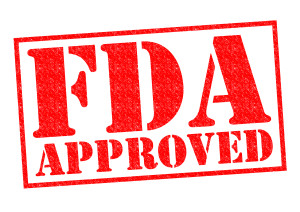OFEV (nintedanib) is one of two medications approved by the FDA (Food and Drug Administration) in October, 2014 to treat idiopathic pulmonary fibrosis. OFEV (nintedanib) is categorized as a kinase inhibitor that blocks multiple pathways that may be involved in the scarring of lung tissue. The mechanism of action involves turning off signaling molecules that are overactive in IPF.
FDA Approval of OFEV (nintedanib) to Treat Idiopathic Pulmonary Fibrosis
 The FDA approval of OFEV is based on findings from one Phase 2 trial (TOMORROW™; NCT00514683) and two Phase 3 trials (INPULSIS™-1 and INPULSIS™-2; NCT01335464 and NCT01335477). The data shows that patients taking OFEV (nintedanib) had less decline in lung function over time than those patients taking a placebo. The studies specifically compared the forced vital capacities (the amount of air that can be forcibly exhaled from the lungs after taking the deepest breath possible) of patients on medication versus those on a placebo. FVC (forced vital capacity) is measured via spiromety.
The FDA approval of OFEV is based on findings from one Phase 2 trial (TOMORROW™; NCT00514683) and two Phase 3 trials (INPULSIS™-1 and INPULSIS™-2; NCT01335464 and NCT01335477). The data shows that patients taking OFEV (nintedanib) had less decline in lung function over time than those patients taking a placebo. The studies specifically compared the forced vital capacities (the amount of air that can be forcibly exhaled from the lungs after taking the deepest breath possible) of patients on medication versus those on a placebo. FVC (forced vital capacity) is measured via spiromety.
How is OFEV (nintedanib) Taken?
OFEV (nintedanib) is a capsule that should be taken orally with food twice per day approximately 12 hours apart. The recommended  dose is 150mg twice daily. OFEV (nintedanib) is available in two strengths, 100mg and 150mg. The lower dosage of 100mg can be used for patients with intolerable side effects to the 150mg dosage. If the 100mg twice per day dose is not tolerated the prescribing physician may discontinue the treatment.
dose is 150mg twice daily. OFEV (nintedanib) is available in two strengths, 100mg and 150mg. The lower dosage of 100mg can be used for patients with intolerable side effects to the 150mg dosage. If the 100mg twice per day dose is not tolerated the prescribing physician may discontinue the treatment.
Possible Side Effects from OFEV (nintedanib)
The most common side effects of OFEV (nintedanib) are gastrointestinal and may include diarrhea, nausea, abdominal pain, vomiting and decreased appetite/weight. Other side effects that may occur are liver enzyme elevation, headache, and high blood pressure. Some patients may require a dose reduction if side effects are intolerable. Blood tests are required to monitor liver function monthly for the first six months then quarterly there after. There were increased reports of bleeding and clotting for patients taking OFEV (nintedanib) versus a placebo during clinical trials. Patients should report any unusual bleeding to their physician immediately.
OFEV (nintedanib) is Pregnancy category D. It can cause fetal harm when administered to a pregnant woman. Patients of child bearing potential should use birth control while taking OFEV (nintedanib) and for at least three months after stopping the medication.
How to Get Started On OFEV (nintedanib)
 OFEV (nintedanib) is an expensive specialty medication. A prescription may cost up to $96,000 per year or $8,000 per month. For this reason the medication is not available at many local pharmacies but rather a select group of specialty and local pharmacies. Once you and your doctor have decided that OFEV (nintedanib) is the appropriate medication to treat your idiopathic pulmonary fibrosis your physician will send a script to one of the select pharmacies that can provide the therapy. The drug manufacturer has established OPEN DOORS™. This program is designed to help patients navigate insurance coverage and financial assistance options as wells as provide nursing services. If the out of pocket cost of this medication is prohibitive contact the prescribing physician’s office immediately as they will know of assistance programs or foundations to apply to for help.
OFEV (nintedanib) is an expensive specialty medication. A prescription may cost up to $96,000 per year or $8,000 per month. For this reason the medication is not available at many local pharmacies but rather a select group of specialty and local pharmacies. Once you and your doctor have decided that OFEV (nintedanib) is the appropriate medication to treat your idiopathic pulmonary fibrosis your physician will send a script to one of the select pharmacies that can provide the therapy. The drug manufacturer has established OPEN DOORS™. This program is designed to help patients navigate insurance coverage and financial assistance options as wells as provide nursing services. If the out of pocket cost of this medication is prohibitive contact the prescribing physician’s office immediately as they will know of assistance programs or foundations to apply to for help.